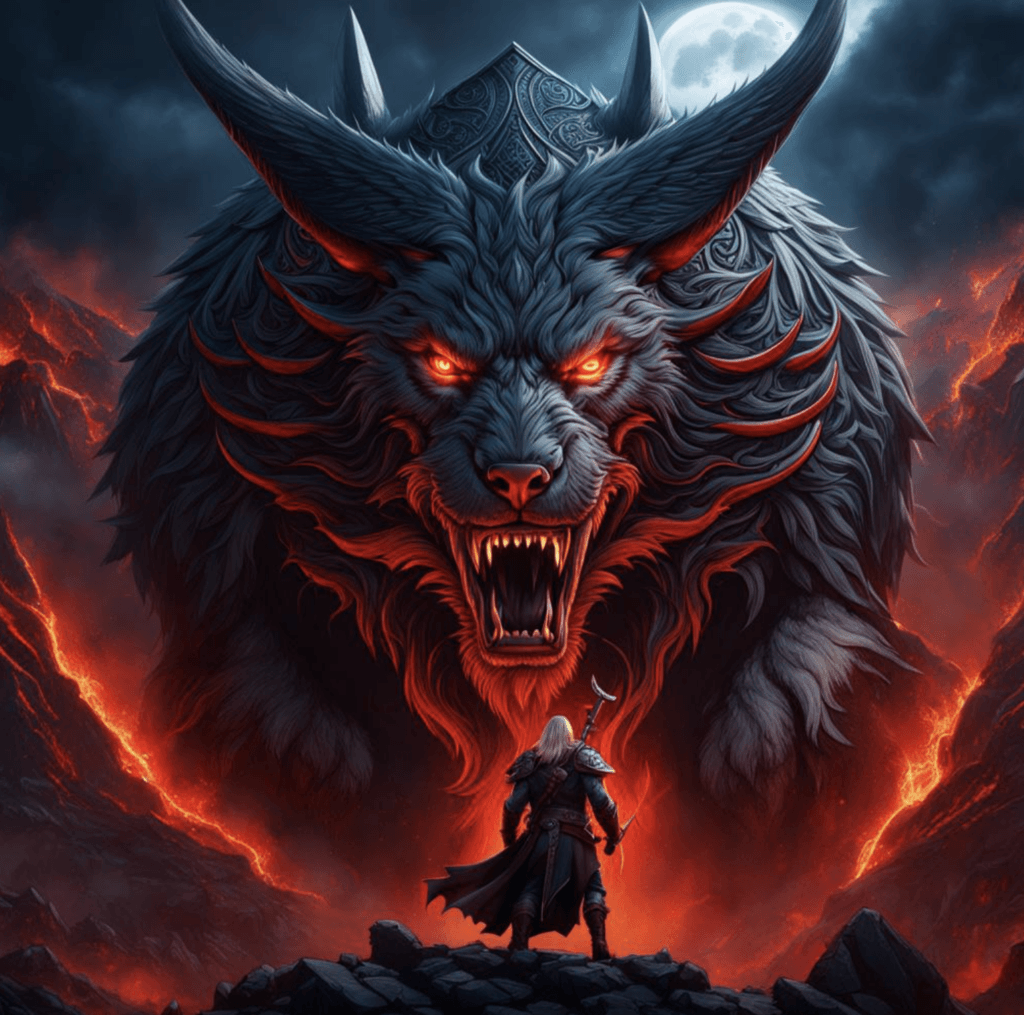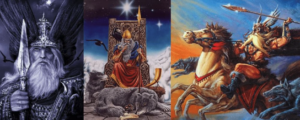Fenrir, also known as Fenrisúlfr or Fenris Wolf, was a gigantic and terrible wolf in Norse mythology. According to the Poetic Edda and Prose Edda, Fenrir was foretold to kill the god Odin during the events of Ragnarök, but would also be killed by Odin’s son Vidar. Fenrir was an important figure in Norse eschatology and his story and role in Ragnarök has endured in modern works that draw upon Norse mythology.
Origin and Nature
Fenrir was the son of Loki and the female jötunn Angrboða. Along with the world serpent Jörmungandr and the goddess Hel, Fenrir was one of Loki’s three monstrous children with Angrboða. In the Poetic Edda, Fenrir is described as a wolf, while in the Prose Edda he is specifically referred to as a wolf (Fenrisúlfr). Due to his immense size and strength, Fenrir took on a more draconic nature resembling a mythical beast.
Fenrir grew rapidly from infancy and the gods became wary of his growing power, seeing him as a threat. Some gods, including Odin, went to visit the wolf pup and see his development. When they arrived, Fenrir had already grown to enormous proportions. The gods foresaw that he would one day play an integral role in the prophesied events of Ragnarök.
Binding of Fenrir
The gods requested that Fenrir visit them at their home god Asgard. However, fearing him, they invited him only if he allowed a magical fetter called Gleipnir to be placed around his legs as a demonstration of good faith. Made from six magical components that included “a woman’s beard, the noise of a cat’s footfall, the roots of stones, the sinews of bears, the breath of fish, [and] the spittle of birds,” Gleipnir was thin as a silken ribbon but unbreakably strong.
Fenrir was deeply suspicious of the gods’ intention but did not want to appear afraid. He agreed to be bound by Gleipnir if one of the gods placed their hand in his mouth as a pledge that the fetter was placed safely. Only the one-handed god Tyr was willing to do so. When Fenrir realized he could not break free, he bit off Tyr’s hand in his anger and distress. The gods learned from this that Fenrir was indeed dangerous and posed a serious threat as his rapid growth had indicated. Fenrir was left bound on the island Lyngvi until Ragnarök.

Prophecy of Ragnarök
In the Poetic Edda poem Völuspá and in Snorri Sturluson’s Prose Edda, a völva or seeress speaks infamously of the events leading up to Ragnarök, the end of the world. She recounts how Fenrir will break free from his magical bonds on the island and seek vengeance:
“The chains will burst and Fenrir run,
The Monster awful shall proceed,
Brothers shall fight and each other kill,
Even families shall not be spared.”
Fenrir’s release and rampage is one of the earliest signs that Ragnarök is underway. He will go on to kill the Allfather Odin himself in ferocious battle. Only later would Fenrir be defeated and die by the hands of Vidar, Odin’s son and one of the few gods foretold to survive Ragnarök.
In Modern Works
Fenrir’s immense size, ferocity, and role in foretold in the destruction of the gods at Ragnarök has ensured his influence persists in modern works inspired by Norse mythology. He has been referenced or directly portrayed in novels, video games, films and television shows set in Nordic-inspired fantasy worlds. Some examples of Fenrir’s modern influence include:
- In J.R.R. Tolkien’s Middle-earth legendarium, the large wolf Carcharoth that maims Beren is seen as having been inspired by Fenrir.
- Fenrir Greyback is a dangerous werewolf character in the Harry Potter books by J.K. Rowling, drawing upon Fenrir’s savage and monstrous nature.
- Fenris is encountered as the main antagonist early on in Rick Riordan’s Magnus Chase series, appearing as a gigantic serpent-wolf hybrid.
- The 2018 video game God of War portrays Fenrir as one of the main enemies Kratos must defeat during his quest in Norse lands.
- The character Fenrys in Sarah J. Maas’ Throne of Glass series can transform into a massive, Fenrir-like wolf.
- In the Marvel Cinematic Universe film Thor: Ragnarok (2017), Fenrir is depicted as one of Hela’s undead wolf companions during her rule of Helheim.
So while bound until Ragnarök in Norse tales, Fenrir the monstrous wolf continues to inspire fearsome characters in modern fiction through his formidable portrayal in medieval Icelandic sources. His guaranteed killing of Odin ensures his lasting significance in Norse eschatology and his menacing appearance fuels ongoing creative works.




